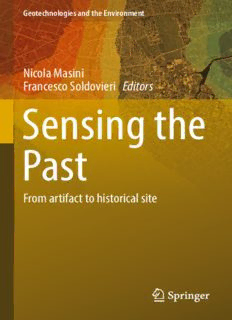
Sensing the Past: From artifact to historical site PDF
Preview Sensing the Past: From artifact to historical site
Geotechnologies and the Environment Nicola Masini Francesco Soldovieri E ditors Sensing the Past From artifact to historical site Geotechnologies and the Environment Volume 16 Serieseditors Jay D. Gatrell, Geography and Environmental Studies, Bellarmine University Louisville,KY40205,USA RyanR.Jensen,DepartmentofGeography,BrighamYoungUniversity,Provo,UT, USA The Geotechnologies and the Environment series is intended to provide specialists in the geotechnologies and academics who utilize these technologies, with anopportunity to share novel approaches, present interesting (sometimes counter-intuitive) case studies, and, most importantly, to situate GIS, remote sensing, GPS, the internet, new technologies, and methodological advances in a real world context. In doing so, the books in the series will be inherently applied and reflect the rich variety of research performed by geographers and allied professionals. Beyond the applied nature of many of the papers and individual contributions, theseriesinterrogatesthedynamicrelationshipbetweennatureandsociety.Forthis reason, many contributors focus on human-environment interactions. The series is not limited to an interpretation of the environment as nature per se. Rather, the series “places” people and social forces in context and thus explores the many socio-spatial environments humans construct for themselves as they settle the landscape. Consequently, contributions will use geotechnologies to examine both urbanandrurallandscapes. Moreinformationaboutthisseriesathttp://www.springer.com/series/8088 Nicola Masini • Francesco Soldovieri Editors Sensing the Past From artifact to historical site 123 Editors NicolaMasini FrancescoSoldovieri CNR-IBAMInstituteofArchaeological InstituteforElectromagneticSensing andMonumentalHeritage oftheEnvironment(CNR-IREA) TitoScalo,PZ,Italy Napoli,Italy ISSN2365-0575 ISSN2365-0583 (electronic) GeotechnologiesandtheEnvironment ISBN978-3-319-50516-9 ISBN978-3-319-50518-3 (eBook) DOI10.1007/978-3-319-50518-3 LibraryofCongressControlNumber:2017936470 ©SpringerInternationalPublishingAG2017 Thisworkissubjecttocopyright.AllrightsarereservedbythePublisher,whetherthewholeorpartof thematerialisconcerned,specificallytherightsoftranslation,reprinting,reuseofillustrations,recitation, broadcasting,reproductiononmicrofilmsorinanyotherphysicalway,andtransmissionorinformation storageandretrieval,electronicadaptation,computersoftware,orbysimilarordissimilarmethodology nowknownorhereafterdeveloped. Theuseofgeneraldescriptivenames,registerednames,trademarks,servicemarks,etc.inthispublication doesnotimply,evenintheabsenceofaspecificstatement,thatsuchnamesareexemptfromtherelevant protectivelawsandregulationsandthereforefreeforgeneraluse. Thepublisher,theauthorsandtheeditorsaresafetoassumethattheadviceandinformationinthisbook arebelievedtobetrueandaccurateatthedateofpublication.Neitherthepublishernortheauthorsor theeditorsgiveawarranty,expressorimplied,withrespecttothematerialcontainedhereinorforany errorsoromissionsthatmayhavebeenmade.Thepublisherremainsneutralwithregardtojurisdictional claimsinpublishedmapsandinstitutionalaffiliations. Printedonacid-freepaper ThisSpringerimprintispublishedbySpringerNature TheregisteredcompanyisSpringerInternationalPublishingAG Theregisteredcompanyaddressis:Gewerbestrasse11,6330Cham,Switzerland Foreword “Social and Cultural Innovation” is a syntagma that has become current usage amongresearchersinrecentyearsinresponsetothenamechosenbytheEuropean Strategy Forum on Research Infrastructures (RIs) for the working group whose objective is the landmarks and projects that are primarily connected with the social sciences and humanities.1 For itself, innovation means the creation of new productsandservicesbybringingtothemarketanewidea.Althoughfundamental researchiscuriositydriven,italsohasatranslationalimpact,becausethetransferof knowledgemakesinnovationpossible,andinnovationisproductdriven,insofaras itgeneratesnewproductsandproductionlines.Innovationistheaffairofresearch councils all over the world, which are quite different from both universities and academies. Research councils were founded about a century ago, at the time of World War I, whereas universities date back to the Middle Ages and academies to the Renaissance. These differ because universities are devoted to teaching and professorsarefreetoteachandinvestigatewhatevertheylikeandacademieswere fundedbykingswhowantedscholarstoliveatcourt,sothattheymightbeableto posequestionsoftheirowninterestandreceiveanswers;incontrast,governments fundedresearchcouncilstoachieveresultsofstrategicrelevanceforthecountry. TheMilanDeclarationonCultureasanInstrumentofDialogueAmongPeoples, unanimouslyadoptedbytheMinistersofCultureof80countriesattheinternational conferenceof31Julyto4August2015thatwasorganizedbytheItalianMinistry ofCulturalHeritageandActivitiesandTourismattheExpoinMilan,statesthat: CulturalHeritageisthemirrorofhistory,civilizationandofthesociety,whichisexpectedto protectit.CulturalHeritage,bothtangibleandintangible,isalsotheessenceofidentity,the memoryofpeoplesandtheirpastandpresentcivilizations.Itexpresses,atthesametime, universallyrecognizedvaluesoftolerance,dialogue,andmutualunderstanding:::thework ofmanandhisextraordinarytalentmustbeprotectedandpreservedforthebenefitoffuture generations. Knowledgeconservation,protection,andusetriggerintegrationpolicies;theyalso promotecultural,economic,andsocialgrowth.Wearetalkingaboutareassuchas knowledgeandinsituprotectionofculturalcontextsandartifacts,postwararcheol- ogy,virtualreality,andsustainablemuseography,2whoseimpactimplies(a)making v vi Foreword culturalheritageinstrumentalforscienceandculturaldiplomacy;(b)protectingand promoting cultural diversity; (c) documenting, conserving, monitoring, and using culturaldiversity;andeventually(e)protectingitfromenvironmentalandanthropic threats in the Middle East and in North Africa. In Brussels,the strategic approach toculturaldiplomacypointstoculturaldiversityasanintegralpartofthevaluesof the European Union. The 2016 Joint Communication to the European Parliament and the Council: Towards an EU Strategy for International Cultural Relations of the High Representative of the Union for Foreign Affairs and Security Policy has outlinedthefollowingfiveguidingprinciples: 1. Promoteculturaldiversityandrespectforhumanrights. 2. Fostermutualrespectandinterculturaldialogue. 3. Ensurerespectforcomplementarityandsubsidiarity. 4. Encourageacross-cuttingapproachtoculture. 5. Promoteculturethroughexistingframeworksforcooperation. Thecurrentmigrantandrefugeecrisishasmadeitclearhowurgentithasbecome for local, regional, national, and international administrations to work out policies of social and cultural innovation to the advantage of new citizens that make them welcomeinfulldignity. Thegreatchallengeisthepassagefromdataofsciencetodataofhumanities.The EuropeanUnionhasrecognizedtheneedandurgencytoprovideadvancedfacilities for interdisciplinary, cutting-edge research in social and cultural innovations. The maingoalistoaddresseveryaspectofscienceandtechnologyrelatedtothefield, offering innovative solutions to the societal challenges of the new millennium. As amatteroffact,socialandculturalinnovationresearchersalsoareconfrontedwith hugeamountsofdataofincreasingcomplexityinhighlyinterdisciplinarysettings. LetusonlythinkofenablingtechnologiessuchasNFC(near-fieldcommunication), CRM (content rights management), contents-aware networks (fruition and enjoy- ment),low-latencynetworks(warningandsecurity),andhuge-bandwidthnetworks (augmentedreality). The object of Sensing the Past is to provide readers and users with top-rate solutions for data analysis in archeology and cultural heritage, in situ noninvasive technologiesformonumentsandartifacts,andgenerallyICTinformationandcom- munication technology) and sensing technologies for cultural heritage. Currently, six research infrastructures for “Social and Cultural Innovation” are operational. Amongthem,theE-RIHS(EuropeanResearchInfrastructureforHeritageScience) createssynergyforamultidisciplinaryapproachtoheritageinterpretation,preserva- tion,documentation,andmanagement.SensingthePastisasubstantialcontribution towardtheimplementationofthegrandItalianprojectofestablishingtheEuropean ResearchInfrastructureforHeritageScience. Rome,Italy RiccardoPozzo Foreword vii Notes 1. http://www.esfri.eu/working-groups/social-and-cultural-innovation:“TheSocial and Cultural Innovation SWG proposes possible solutions (related to RIs) that are able to help tackle the Grand Challenges facing society, such as health or demographicchange,orthe‘Inclusive,innovativeandsecuresocieties’challenge from the third pillar of Horizon 2020, called ‘Tackling societal challenges.’ It establishespossiblemethodsthroughwhichsocialsciencesandhumanitiescould be used as an evaluation criterion for the activity of other RIs in the ESFRI roadmap (e.g., social impact). It also explores how RIs can contribute to social innovationorbetterknowledgetransfertowardsociety.” 2. For example, satellites and topographic techniques, drones and sensors for heritage protection in wide areas, advanced diagnostic systems, nanomaterials and nanotechnologies for conservation, 3D for the enhancement of cognitive access in historical and archaeological contexts, methodologies and protocols for3Drenderinginhazardouscontexts,monitoringartifacts–contextinteraction, advancedexhibitionsystems,smartshowcases. Contents 1 CulturalHeritageSitesandSustainableManagementStrategies .... 1 NicolaMasiniandFrancescoSoldovieri PartI RemoteSensingandGeophysicsTechnologies:Data AnalysisforApplicationsintheFieldofArchaeology andCulturalHeritage 2 SensingthePastfromSpace:ApproachestoSiteDetection........... 23 NicolaMasiniandRosaLasaponara 3 PreservingthePastfromSpace:AnOverviewofRisk EstimationandMonitoringTools......................................... 61 RosaLasaponaraandNicolaMasini 4 LiDAR for Archaeological Research and the Study ofHistoricalLandscapes................................................... 89 AdrianS.Z.Chase,DianeZ.Chase,andArlenF.Chase 5 SARforLandscapeArchaeology ......................................... 101 DeodatoTapeteandFrancescaCigna 6 DInSARfortheMonitoringofCulturalHeritageSites................ 117 Manuela Bonano, Mariarosaria Manzo, Francesco Casu, MicheleManunta,andRiccardoLanari 7 AWindowfortheHiddenPast:RevealingArchitectural RemainsBasedonFieldSpectroscopyDataAnalysis.................. 135 AthosAgapiou 8 SeismicandSonicApplicationsonArtifactsandHistorical Buildings..................................................................... 153 GiovanniLeucci ix x Contents 9 Ground-Penetrating Radar: Technologies and Data ProcessingIssuesforApplicationsintheFieldofCultural Heritage...................................................................... 175 RaffaelePersicoandMotoyukiSato 10 GeomagnetometryforArchaeology ...................................... 203 M.Fedi,F.Cella,G.Florio,M.LaManna,andV.Paoletti PartII InSituNoninvasiveTechnologiesforInvestigating MonumentsandArtifacts 11 Infrared Thermography: From Sensing Principle toNondestructiveTestingConsiderations ............................... 233 JeanDumoulin 12 Investigating Surficial Alterations of Natural Stone byUltrasonicSurfaceMeasurements .................................... 257 ThomasMeier,MichalAuras,MoritzFehr,DanielKöhn, Luigia Cristiano, Robert Sobott, Ilaria Mosca, Hans Ettl, Felix Eckel, Tim Steinkraus, Ercan Erkul, Detlef Schulte-Kortnack, Karin Sigloch, Filiz Bilgili, ElenaDiGioia,andClaudioParisiPresicce 13 Hyperspectral Sensors for the Characterization ofCulturalHeritageSurfaces............................................. 289 Mara Camaiti, Marco Benvenuti, Pilario Costagliola, FrancescoDiBenedetto,andSandroMoretti 14 TerahertzWavesandCulturalHeritage:State-of-the-Art andPerspectives ............................................................ 313 IlariaCatapano,MarcelloPicollo,andKaoriFukunaga 15 FF-XRF, XRD, and PIXE for the Nondestructive InvestigationofArchaeologicalPigments................................ 325 Francesco Paolo Romano, Lighea Pappalardo, Giacomo Biondi, Claudia Caliri, Nicola Masini, FrancescaRizzo,andHellenCristineSantos PartIII InformationandCommunicationsTechnologyand SensingTechnologiesforCulturalHeritage 16 WirelessCommunicationPlatformsforBuiltandNatural HeritageMonitoring ....................................................... 339 MaríaInmaculadaMartínez-GarridoandRafaelFortGonzález
Description: